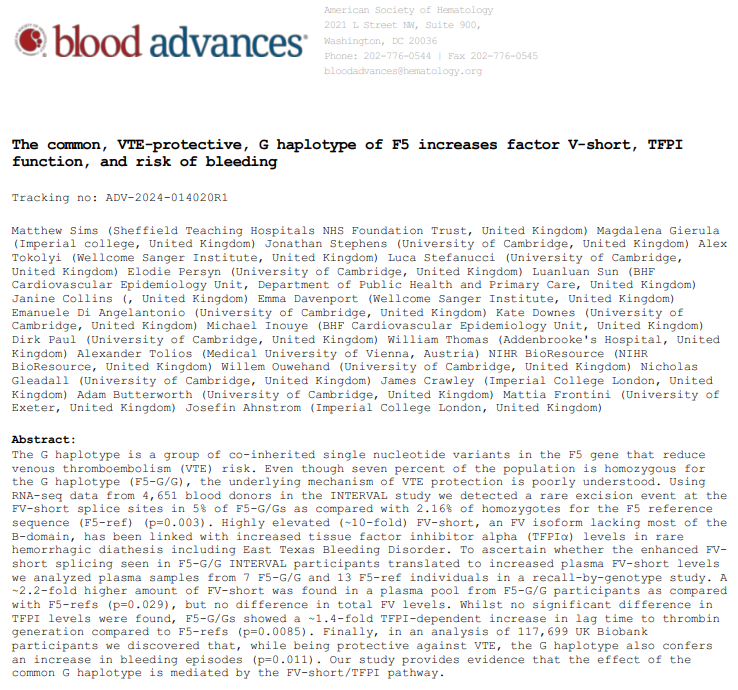ROTEC – Inherited changes leading to altered levels of a blood protein, tissue factor pathway inhibitor and risk of cardiovascular disease
Study code
NBR41
Lead researcher
Dr William Astle
Study type
Participant re-contact
Institution or company
University of Cambridge
Researcher type
Academic
Speciality area
Haematology, Cardiovascular Disease
Summary
Tissue factor pathway inhibitor (TFPI) is a protein released into the blood stream by small blood cells called platelets and the cells lining blood vessels. TFPI provides a brake on the body’s clotting system such that if levels are increased this reduces the tendency of a person to form a blood clot. A recent large study in healthy volunteers showed that a common change in the DNA code (called a variant) affects the levels of TFPI. In our study, ROTEC, we will invite 20 participants from the NIHR BioResource to have a blood sample taken, which we will use to work out why these different TFPI levels occur in persons with and without the variant. We anticipate this research will help to identify potential new reasons for why some people are more prone to blood clots and cardiovascular diseases than others and help researchers find novel treatments for reducing the risk of conditions such as heart attacks and strokes.
Research publication
Sims MC, Gierula M, Stephens JC, Tokolyi A, Stefanucci L, Persyn E, Sun L, Collins JH, Davenport E, Di Angelantonio E, Downes K, Inouye M, Paul DS, Thomas W, Tolios A, BioResource N, Ouwehand WH, Gleadall NS, Crawley JTB, Butterworth AS, Frontini M, Ahnstrom J.Blood Adv. 2024 Oct 4:bloodadvances.2024014020.
doi: 10.1182/bloodadvances.2024014020
Main Findings
-
Individuals homozygous for the F5 G haplotype (F5-G/G) have increased alternative F5 splicing resulting in increased plasma FV-short levels
-
F5-G/G individuals have a TFPI-dependent increase in lag time to thrombin generation, reduced VTE risk, and increased bleeding
The G haplotype is a group of co-inherited single nucleotide variants in the F5 gene that reduce venous thromboembolism (VTE) risk. Even though seven percent of the population is homozygous for the G haplotype (F5-G/G), the underlying mechanism of VTE protection is poorly understood. Using RNA-seq data from 4,651 blood donors in the INTERVAL study we detected a rare excision event at the FV-short splice sites in 5% of F5-G/Gs as compared with 2.16% of homozygotes for the F5 reference sequence (F5-ref) (p=0.003). Highly elevated (~10-fold) FV-short, an FV isoform lacking most of the B-domain, has been linked with increased tissue factor inhibitor alpha (TFPIα) levels in rare hemorrhagic diathesis including East Texas Bleeding Disorder. To ascertain whether the enhanced FV-short splicing seen in F5-G/G INTERVAL participants translated to increased plasma FV-short levels we analyzed plasma samples from 7 F5-G/G and 13 F5-ref individuals in a recall-by-genotype study. A ~2.2-fold higher amount of FV-short was found in a plasma pool from F5-G/G participants as compared with F5-refs (p=0.029), but no difference in total FV levels. Whilst no significant difference in TFPI levels were found, F5-G/Gs showed a ~1.4-fold TFPI-dependent increase in lag time to thrombin generation compared to F5-refs (p=0.0085). Finally, in an analysis of 117,699 UK Biobank participants we discovered that, while being protective against VTE, the G haplotype also confers an increase in bleeding episodes (p=0.011). Our study provides evidence that the effect of the common G haplotype is mediated by the FV-short/TFPI pathway.
